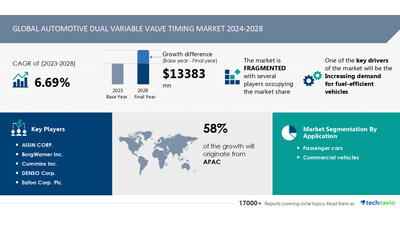Subject: MRR
Automotive Dual Variable Valve Timing Market size is set to grow by USD 13.38 billion from 2024-2028, Increasing demand for fuel-efficient vehicles boost the market, Technavio
NEW YORK, July 4, 2024 /PRNewswire/ -- The global automotive dual variable valve timing market size is estimated to grow by USD 13.38 billion from 2024-2028, according to Technavio. The market is estimated to grow at a CAGR of 6.69% during the forecast period. Increasing demand for fuel-efficient vehicles is driving market growth, with a trend towards development of electric dual vvt technology. However, increasing focus on adoption of evs globally poses a challenge. Key market players include AISIN CORP., BorgWarner Inc., Cummins Inc., DENSO Corp., Eaton Corp. Plc, Ford Motor Co., General Motors Co., Hitachi Ltd., Honda Motor Co. Ltd., Hyundai Motor Co., MAHLE GmbH, Mitsubishi Electric Corp., Precision Camshaft Ltd., Renault SAS, Schaeffler AG, Stellantis NV, Tenneco Inc., Toyota Motor Corp., Volkswagen AG, and Zhejiang Geely Holding Group Co. Ltd..
Get a detailed analysis on regions, market segments, customer landscape, and companies- View the snapshot of this report
Automotive Dual Variable Valve Timing Market Scope | |
Report Coverage | Details |
Base year | 2023 |
Historic period | 2018 - 2022 |
Forecast period | 2024-2028 |
Growth momentum & CAGR | Accelerate at a CAGR of 6.69% |
Market growth 2024-2028 | USD 13383 million |
Market structure | Fragmented |
YoY growth 2022-2023 (%) | 6.15 |
Regional analysis | APAC, Europe, North America, Middle East and Africa, and South America |
Performing market contribution | APAC at 58% |
Key countries | China, US, Japan, Germany, and France |
Key companies profiled | AISIN CORP., BorgWarner Inc., Cummins Inc., DENSO Corp., Eaton Corp. Plc, Ford Motor Co., General Motors Co., Hitachi Ltd., Honda Motor Co. Ltd., Hyundai Motor Co., MAHLE GmbH, Mitsubishi Electric Corp., Precision Camshaft Ltd., Renault SAS, Schaeffler AG, Stellantis NV, Tenneco Inc., Toyota Motor Corp., Volkswagen AG, and Zhejiang Geely Holding Group Co. Ltd. |
Market Driver
The global automotive dual variable valve timing (VVT) market is witnessing significant growth due to the emergence of electric DVVT (eDVVT) technology. EDVVT offers advantages such as precise and dynamic control over valve timing, faster and more accurate adjustments, and improved engine performance and fuel efficiency. Automakers prefer eDVVT systems due to their potential to enhance engine power, torque, and overall efficiency. BrogWarner's P2Drive eDVVT system is an example of this innovation. As the automotive industry shifts toward electrification and hybridization, eDVVT technology becomes increasingly important for optimizing internal combustion engines (ICEs) in hybrid vehicles, reducing emissions, and enhancing efficiency. This trend is expected to drive the growth of the global automotive dual VVT market during the forecast period.
The Automotive Dual Variable Valve Timing (VVT) market is experiencing significant growth due to the increasing demand for improved engine performance and fuel efficiency. VVT technology allows for optimal engine performance at various RPM levels, resulting in reduced emissions and enhanced power output. Fuel economy is a key trend in the automotive industry, and VVT technology plays a crucial role in achieving this goal. Additionally, the cost-effective nature of VVT systems makes them an attractive option for automakers seeking to meet stringent emissions regulations. The future of the Automotive VVT market looks promising, with continued advancements in technology and increasing adoption rates.
Research report provides comprehensive data on impact of trend. For more details- Download a Sample Report
Market Challenges
? The automotive dual variable valve timing market faces challenges due to the growing trend towards electric vehicles (EVs). Governments and consumers have significantly increased spending on EVs, surpassing USD 400 billion in 2022. The Indian Government's Faster Adoption and Manufacturing of Electric Vehicles (FAME) program offers incentives for charging infrastructure and encourages EV adoption. This shift from internal combustion engine (ICE) vehicles to EVs has reduced the demand for engines and their components, including dual variable valve timing systems. Thus, the market growth may be impeded due to the increasing adoption of EVs.
? The Automotive Dual Variable Valve Timing (VVT) market faces several challenges. One challenge is the complexity of implementing VVT technology in various vehicle models and engines. Another challenge is the cost of developing and manufacturing VVT systems that offer significant fuel efficiency and power improvements. Additionally, stringent emissions regulations require continuous advancements in VVT technology to meet these standards. Furthermore, the increasing popularity of electric and hybrid vehicles may impact the demand for VVT technology in traditional internal combustion engines. Lastly, the competition among automotive suppliers and OEMs to offer the most advanced and cost-effective VVT solutions adds to the market's challenges.
For more insights on driver and challenges - Request a sample report!
Segment Overview
This automotive dual variable valve timing market report extensively covers market segmentation by
- Application
- 1.1 Passenger cars
- 1.2 Commercial vehicles
- Type
- 2.1 Hydraulic cam phaser
- 2.2 Electric cam phaser
- Geography
- 3.1 APAC
- 3.2 Europe
- 3.3 North America
- 3.4 Middle East and Africa
- 3.5 South America
1.1 Passenger cars- The passenger cars segment dominates the global automotive dual variable valve timing market due to the integration of this technology in modern vehicles. Dual VVT optimizes engines, enhances fuel efficiency, and reduces emissions, driving sales in developing economies like China, where electric passenger cars accounted for 22% of total sales in 2022. Stringent emission norms and the demand for fuel-efficient vehicles further fuel market growth. Innovative systems like Toyota's VVT-i and Honda's i-VTEC improve performance and efficiency. Regulations on passenger vehicle emissions will continue to push market expansion.
For more information on market segmentation with geographical analysis including forecast (2024-2028) and historic data (2017-2021) - Download a Sample Report
Research Analysis
The Automotive Dual Variable Valve Timing (VVT) Market encompasses the development, production, and implementation of advanced VVT systems in various vehicle types, including passenger vehicles and commercial vehicles. These systems, which can be gasoline or diesel-powered, optimize engine performance and reduce emissions by adjusting the timing of valve opening and closing during the intake and exhaust strokes. Gasoline VVT systems, such as Cam-phasing and Cam-phasing plus changing, improve fuel efficiency and reduce greenhouse gas emissions, including carbon dioxide and methane, in passenger cars and light commercial vehicles. Similarly, Diesel VVT systems enhance efficiency and lower emissions in diesel-powered vehicles. Regulatory bodies play a crucial role in setting emission standards and promoting the adoption of these advanced technologies. Start-stop systems, which are often integrated with VVT systems, help reduce idling and improve fuel economy during light acceleration. Overall, the Automotive Dual Variable Valve Timing Market is a significant contributor to the reduction of emissions from the transportation sector.
The Automotive Dual Variable Valve Timing (VVT) market refers to the technology that optimizes engine performance by adjusting the timing of intake and exhaust valves. This system improves fuel efficiency, reduces emissions, and enhances engine power. VVT systems are essential in modern engines, particularly in turbocharged and supercharged engines. The technology is widely used in various vehicle types, including passenger cars and commercial vehicles. The market for Automotive DVTT is expected to grow due to increasing demand for fuel-efficient and eco-friendly vehicles. Additionally, stringent emission regulations and advancements in engine technology are driving the market's growth. The system's components include camshafts, crankshafts, timing belts or chains, and actuators. The market's key drivers are the increasing demand for downsizing engines, the need for improved engine performance, and the growing trend towards electrification in the automotive industry.
Table of Contents:
1 Executive Summary
2 Market Landscape
3 Market Sizing
4 Historic Market Size
5 Five Forces Analysis
6 Market Segmentation
- Application
- Passenger Cars
- Commercial Vehicles
- Type
- Hydraulic Cam Phaser
- Electric Cam Phaser
- Geography
- APAC
- Europe
- North America
- Middle East And Africa
- South America
7 Customer Landscape
8 Geographic Landscape
9 Drivers, Challenges, and Trends
10 Company Landscape
11 Company Analysis
12 Appendix
About Technavio
Technavio is a leading global technology research and advisory company. Their research and analysis focuses on emerging market trends and provides actionable insights to help businesses identify market opportunities and develop effective strategies to optimize their market positions.
With over 500 specialized analysts, Technavio's report library consists of more than 17,000 reports and counting, covering 800 technologies, spanning across 50 countries. Their client base consists of enterprises of all sizes, including more than 100 Fortune 500 companies. This growing client base relies on Technavio's comprehensive coverage, extensive research, and actionable market insights to identify opportunities in existing and potential markets and assess their competitive positions within changing market scenarios.
Contacts
Technavio Research
Jesse Maida
Media & Marketing Executive
US: +1 844 364 1100
UK: +44 203 893 3200
Email: [email protected]
Website: www.technavio.com/
SOURCE Technavio
These press releases may also interest you
|
News published on and distributed by:





